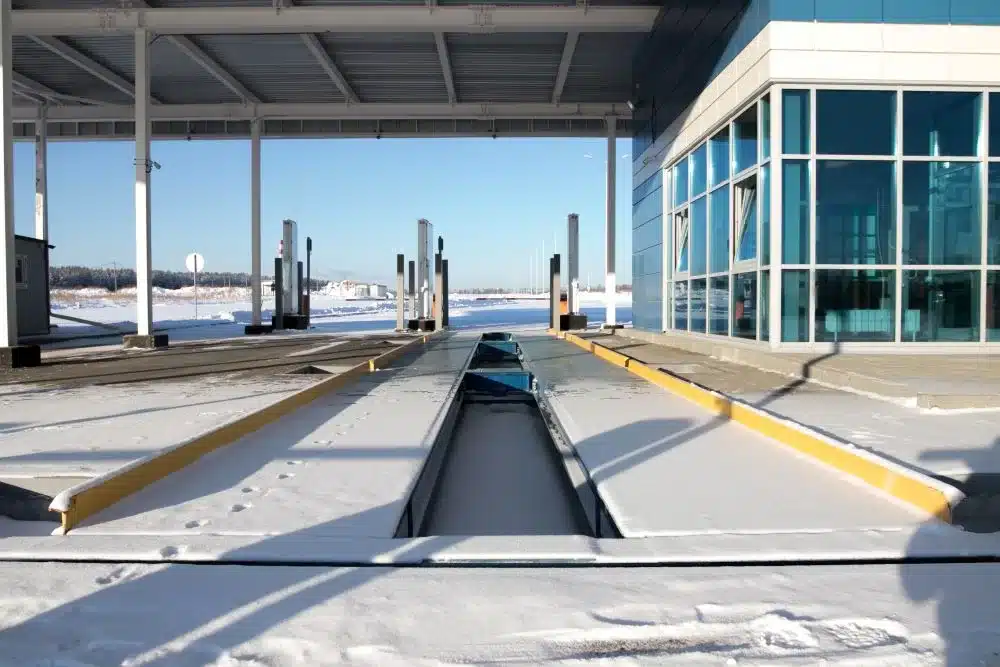 January 24, 2024
January 24, 2024
In a world where every ounce matters – like in mining, oil & gas, and agriculture – truck axle scales are more than just tools; they’re the unsung heroes.
They’re the ones making sure everything is up to the mark, keeping you on the right side of regulations and away from those hefty fines, thanks to their spot-on weight measurements.
But here’s a twist: What happens when nature decides to throw a curveball?
In this blog, we’re diving into an area that often slips under the radar – how weather can really shake things up with the accuracy of truck axle scales.
Understanding How Truck Axle Scale Accuracy Works
Before we jump into how the weather plays its part, let’s break down what scale accuracy really means.
Think of accuracy as the heartbeat of your truck scale – it’s what keeps everything running smoothly, making sure the weight readings you get are on the dot every time.
But here’s the catch: it’s not just about the scale itself.
A bunch of factors, like the whims of the weather, can nudge this accuracy off course.
And why should you care? Well, it’s simple. When your scales start giving you the wrong numbers, it’s not just about a few extra pounds.
Impact of Weather on Scale Performance
Weather’s influence on scale accuracy is multifaceted and significant:
Extreme Temperatures
Truck scales, predominantly metal, react quickly to temperature changes. In hot weather, metal components may expand, while in cold, they contract. These potential fluctuations, if not properly addressed in the design, may lead to inaccurate readings. For instance, a scale might under-register a load in high heat, leading to potential overloading without realizing it.
Moisture and Humidity
Rain, snow, and even high humidity levels can affect a scale’s operation. Moisture can corrode metal parts and short-circuit electrical components, leading to erratic, inaccurate or no readings. This is particularly crucial for scales with electronic components, as moisture is a known enemy of electronic efficiency.
Wind
It’s not just about what’s on the scale; the environment plays a part too. Strong winds can exert force on the vehicle and the scale, leading to skewed weight measurements. For instance, a strong side wind can push against a truck, causing it to exert more pressure on one side of the scale, leading to inaccurate weight distribution readings.
Maintenance and Calibration for Accuracy
Combating weather-related inaccuracies is a matter of vigilance and regular maintenance:
Regular Calibration
Regular calibration is like a health check-up for your scale. It ensures that despite the environmental wear and tear, your scale remains accurate. Consider calibrating more frequently if your scale faces extreme or fluctuating weather conditions.
Temperature and Wind Considerations
Adapting to temperature variations and wind conditions is essential. For example, calibration might need a specialized approach in the height of summer or in the depths of winter, where temperatures may be beyond the NTEP-type approval range. Understanding how your specific scale model reacts to temperature changes can guide appropriate calibration procedures.
Preventing Moisture Buildup
Implementing measures to shield your scale from moisture – such as drainage systems around the scale pit and waterproof covers for electrical components – is crucial. Regular inspections for rust and corrosion, particularly after wet seasons, can catch problems before they impact accuracy.
Technological Advancements for Enhanced Accuracy
Embracing technology can mitigate weather-related issues:
High-Resolution Load Cell Technology
These advanced cells offer more precise readings and are less prone to inaccuracies caused by environmental factors. They provide a more robust and reliable reading, even in less-than-ideal conditions.
Advanced Algorithms
Modern scales come equipped with software that can compensate for certain environmental factors. For instance, algorithms that adjust for wind impact or temperature fluctuations can help maintain accuracy regardless of the weather.
Robust Materials
The evolution in materials used for scale construction means newer models are better equipped to handle adverse weather. Materials resistant to corrosion and temperature-induced deformation keep the scale reliable for longer, even in harsh conditions.
Mastering Scale Accuracy through Maintenance, Calibration, and Technology
It’s undeniable – weather conditions are a constant factor affecting the accuracy of truck axle scales.
However, through regular maintenance, calibration, and leveraging technological advancements, these challenges can be effectively managed.
By committing to regular maintenance and calibration and embracing the latest in technological advancements, these challenges can be more than just managed – they can be mastered.
Knowledge is power in this context: knowing the factors that may lead to scale inaccuracies is the first step.
Next up, and arguably the most important step, is to stay ahead of the game with your scale maintenance. Keeping your scale in top shape and staying in the loop with the latest tech advancements that boost accuracy is key.
By sticking to these practices, you’re not just ticking off a checklist. You’re ensuring that your portable axle scales are always dependable, sharp in precision, and in line with standards – come rain or shine.
Ready to Weather the Storm with Your Truck Axle Scale?
Wondering if your truck axle scale can handle whatever Mother Nature throws its way? Let’s make sure it does.
Don’t hesitate to reach out to us! We’re here to offer you top-notch advice, calibration services, and all the support you need to keep your scale working precisely and reliably.
Remember, the real worth of a truck scale lies in just how spot-on its readings are.
Let’s work together to keep yours measuring up perfectly.


